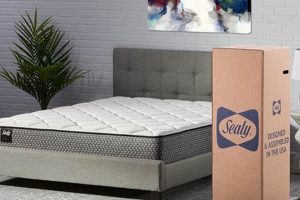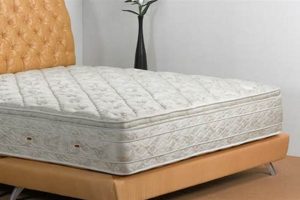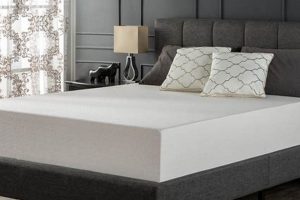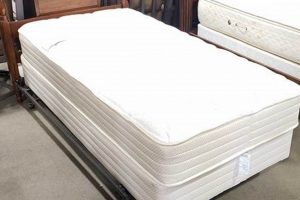The question of whether a particular mattress type requires a specific foundation is a common one among consumers. This query often arises when individuals are considering a mattress purchase or evaluating their existing sleep setup. The necessity of a supporting structure significantly impacts both the longevity and performance of the mattress, influencing sleep quality and overall value.
Proper support extends the lifespan of the mattress and ensures warranty validity. Utilizing an inadequate foundation can lead to sagging, uneven wear, and reduced support, potentially voiding the manufacturer’s guarantee. Furthermore, an appropriate base can improve airflow, preventing moisture buildup and contributing to a more hygienic sleep environment. Historically, box springs were designed to absorb shock and reduce wear on innerspring mattresses; however, contemporary mattress designs and foundation options necessitate a reevaluation of traditional pairings.
This discussion will delve into the support needs of memory foam mattresses. It will examine alternative foundation options, factors to consider when selecting a suitable base, and the potential consequences of choosing an inappropriate support system. Understanding these factors is crucial for maximizing the benefits of a memory foam mattress and ensuring a restful sleep experience.
Guidance on Memory Foam Mattress Support
Proper support is crucial for optimizing the performance and lifespan of a memory foam mattress. Selecting the appropriate foundation will contribute to comfort, longevity, and adherence to warranty requirements.
Tip 1: Evaluate Existing Bed Frames: Assess the suitability of current bed frames. Slatted frames with gaps exceeding two to three inches may not provide adequate support and could contribute to mattress sagging.
Tip 2: Consider Platform Beds: Platform beds, characterized by a solid or closely slatted surface, often provide sufficient support for memory foam mattresses, eliminating the need for a traditional box spring.
Tip 3: Explore Solid Foundations: Solid foundations, typically constructed of wood or metal, offer consistent support across the entire mattress surface, promoting even weight distribution and minimizing the risk of premature wear.
Tip 4: Verify Warranty Requirements: Consult the manufacturer’s warranty to determine specific foundation requirements. Failure to comply with these requirements could invalidate the warranty.
Tip 5: Account for Weight Capacity: Ensure the chosen foundation can adequately support the combined weight of the mattress and its occupants. Exceeding the weight limit can compromise the foundation’s structural integrity.
Tip 6: Assess Height Preferences: Foundation selection influences the overall bed height. Consider personal preferences and physical limitations when determining the desired bed height.
Tip 7: Prioritize Breathability: Select a foundation that promotes adequate airflow beneath the mattress. This is especially important for memory foam, which can sometimes retain heat.
Selecting the appropriate foundation for a memory foam mattress is a critical decision. Careful consideration of these factors will help ensure optimal performance, longevity, and warranty compliance.
The concluding section will summarize key considerations and provide guidance for making an informed decision regarding memory foam mattress support.
1. Foundation Suitability
The concept of Foundation Suitability is intrinsically linked to the question of whether a memory foam mattress requires a box spring. Determining the appropriateness of a support structure directly influences the mattress’s performance, longevity, and adherence to warranty terms. This dictates if the intended support adequately meets the mattress’s structural needs.
- Support Type Compatibility
Memory foam mattresses, unlike traditional innerspring mattresses, often do not require the spring-like support a box spring provides. The dense foam construction typically necessitates a flat, rigid surface for optimal support. Utilizing a box spring could, in some cases, diminish the intended support and contouring benefits of the memory foam.
- Slat Spacing Considerations
If a slatted foundation is chosen, the spacing between the slats is a critical factor. Excessive spacing, generally more than two to three inches, may lead to uneven support and potential sagging of the mattress. A closely spaced or solid surface is generally recommended to ensure uniform weight distribution across the mattress.
- Platform Bed Integration
Platform beds, characterized by their solid or closely slatted surface, are frequently a suitable foundation for memory foam mattresses. Their inherent design often eliminates the need for additional support structures, providing a stable and even surface for the mattress to rest upon. The suitability of a platform bed depends on its construction and weight-bearing capacity.
- Warranty Implications
Many mattress manufacturers specify foundation requirements within their warranty terms. Using an unsuitable foundation, even if it appears to provide adequate support, can invalidate the warranty. Therefore, verifying the manufacturer’s recommendations regarding foundation type is crucial to maintaining warranty coverage.
Foundation Suitability is, therefore, not merely a matter of preference, but a crucial factor in ensuring the proper support and longevity of a memory foam mattress. Careful consideration of these factors, coupled with adherence to manufacturer guidelines, will contribute to an optimal sleep experience and protect the investment in the mattress.
2. Warranty Compliance
Warranty Compliance is a critical consideration when determining the appropriate support structure for a memory foam mattress. Mattress warranties often stipulate specific foundation requirements, and failure to adhere to these conditions can result in the invalidation of the warranty, leaving the consumer without recourse in case of defects or premature wear.
- Foundation Type Specifications
Many mattress manufacturers explicitly state the types of foundations that are acceptable for use with their memory foam mattresses. These specifications may include requirements for a solid platform, closely spaced slats (typically with a maximum gap of two to three inches), or a specific type of box spring designed for use with foam mattresses. Deviation from these specifications can void the warranty.
- Support Structure Integrity
Warranties frequently require that the chosen foundation provides adequate and uniform support across the entire surface of the mattress. Using a damaged, sagging, or otherwise compromised foundation can be construed as a violation of the warranty terms, as it can contribute to uneven wear and premature failure of the mattress. Proof of proper support may be required in the event of a warranty claim.
- Weight Capacity Adherence
Mattress warranties may also specify weight capacity limitations for the foundation. Exceeding the stated weight limit can place undue stress on both the foundation and the mattress, potentially leading to structural damage and invalidating the warranty. Consumers should ensure that the chosen foundation is rated to support the combined weight of the mattress and its occupants.
- Documentation Requirements
In the event of a warranty claim, manufacturers may request documentation to verify that the mattress was used with an appropriate foundation. This documentation could include receipts for the foundation, photographs of the bed setup, or other evidence demonstrating compliance with the warranty terms. Failure to provide sufficient documentation can result in the denial of the claim.
The relationship between foundation selection and Warranty Compliance is inseparable. Selecting a foundation without considering the manufacturer’s specifications is a significant risk, potentially resulting in the loss of warranty coverage and financial implications. Prior to purchasing a memory foam mattress, consumers should thoroughly review the warranty terms and ensure that their chosen foundation meets all stated requirements.
3. Support Requirements
The structural integrity and performance of a memory foam mattress are intrinsically linked to its support requirements. The question of whether a box spring is necessary is secondary to understanding the fundamental need for adequate and appropriate support to ensure longevity, comfort, and the validity of the manufacturer’s warranty.
- Uniform Weight Distribution
Memory foam mattresses require a foundation that provides uniform weight distribution across their entire surface. Unlike innerspring mattresses that rely on the spring system to distribute weight, memory foam conforms to the body’s shape, requiring a stable and even base. Inadequate support can lead to localized pressure points, sagging, and uneven wear, potentially shortening the lifespan of the mattress and diminishing its comfort. For example, a slatted frame with excessively wide gaps may not provide sufficient support, causing the foam to sag between the slats.
- Rigid Foundation
Memory foam mattresses generally perform best on a rigid, non-yielding foundation. This type of support allows the mattress to maintain its shape and provide consistent support to the sleeper. A foundation with excessive give, such as a traditional box spring with worn or weak coils, may not provide the necessary stability and can compromise the contouring benefits of the memory foam. A platform bed with a solid surface or closely spaced slats typically satisfies this requirement.
- Breathability Considerations
While solid support is crucial, breathability is also a factor. Some memory foam mattresses can retain heat, and a foundation that allows for airflow can help to mitigate this issue. Slatted foundations, if properly constructed with appropriate spacing, can provide both support and ventilation. Perforated platforms or foundations with breathable materials can also improve airflow and reduce heat buildup.
- Manufacturer Specifications
Ultimately, the manufacturer’s specifications should dictate the support requirements for a particular memory foam mattress. These specifications often outline the acceptable types of foundations, weight limits, and other relevant criteria. Failure to comply with these recommendations can not only compromise the mattress’s performance but also void the warranty. Therefore, consulting the manufacturer’s guidelines is essential when selecting a foundation.
In conclusion, the determination of whether a box spring is necessary for a memory foam mattress hinges on meeting the mattress’s support requirements. While a traditional box spring may not always be the optimal choice, a suitable foundation, whether it be a platform bed, a slatted frame with appropriate spacing, or a specialized foundation designed for foam mattresses, is essential for ensuring proper support, longevity, and warranty compliance.
4. Mattress Longevity
The lifespan of a memory foam mattress is significantly influenced by the support structure upon which it rests. Selecting an appropriate foundation is paramount to maximizing mattress longevity, preventing premature degradation, and ensuring continued comfort over time. This investigation explores the key facets of this relationship.
- Proper Support and Sagging Prevention
Inadequate support can lead to sagging, particularly in memory foam mattresses. A foundation with insufficient support, such as a box spring with weakened coils or a slatted frame with excessive spacing, allows the mattress to deform unevenly. This localized compression weakens the foam structure over time, resulting in permanent indentations and reduced support. Preventing sagging through proper foundation selection is therefore essential for prolonging mattress life. For example, consistently sleeping in the same spot on a mattress with poor support will cause it to sag faster in that area.
- Weight Distribution and Foam Integrity
Effective weight distribution is critical for maintaining the integrity of the memory foam. A foundation that evenly distributes weight across the entire mattress surface prevents localized stress and compression. This uniform support minimizes the risk of structural damage to the foam layers, preserving their resilience and contouring capabilities. Conversely, a foundation that concentrates weight in specific areas can accelerate foam degradation. Consider a scenario where a heavy individual sleeps on a mattress supported by a frame with a central support beam; the mattress will likely wear out faster along that beam.
- Foundation Material and Airflow
The material composition of the foundation can also affect mattress longevity. Foundations made from breathable materials, such as wood slats or open-weave metal frames, promote airflow and ventilation around the mattress. This airflow helps to dissipate moisture and heat, reducing the risk of mold growth and foam degradation. Conversely, a foundation made from non-breathable materials, such as a solid sheet of plywood, can trap moisture and heat, creating an environment conducive to premature wear. For instance, a memory foam mattress placed directly on a concrete floor will likely degrade faster due to moisture buildup.
- Impact of Movement and Vibration
The foundation’s ability to absorb movement and vibration also contributes to mattress longevity. A rigid foundation transmits more movement and vibration to the mattress, increasing the stress on the foam layers. Over time, this constant movement can weaken the foam structure and reduce its ability to conform to the body. Foundations that incorporate some degree of shock absorption, such as those with flexible slats or specialized suspension systems, can help to mitigate this effect. Imagine a scenario where a mattress is placed on a metal frame in a room prone to vibrations; the vibrations will likely accelerate the breakdown of the foam.
These interconnected factors underscore the importance of selecting a foundation that provides adequate and uniform support, promotes airflow, and minimizes the impact of movement. While a traditional box spring may not always be the optimal choice for a memory foam mattress, the underlying principle remains the same: choosing the right support structure is essential for maximizing the mattress’s lifespan and ensuring years of comfortable sleep. The interplay between the memory foam mattress and its base cannot be ignored, therefore careful foundation choices will enhance value and support.
5. Alternatives Exist
The assertion that alternatives exist is central to answering whether a memory foam mattress requires a box spring. The necessity of a box spring is not absolute; other foundation options can adequately, and in some cases, better support this type of mattress. The availability of alternatives stems from the specific support needs of memory foam, which differ from those of traditional innerspring mattresses. While innerspring mattresses often benefit from the shock absorption and spring-like support of a box spring, memory foam typically requires a firm, flat surface to prevent sagging and ensure proper spinal alignment. Therefore, the relevance of alternatives exist is critical for decision-making.
Common alternatives include platform beds, which offer a solid or closely-slatted surface, and adjustable bases, which allow for customized positioning. Slatted bed frames, provided the slats are closely spaced (generally no more than 2-3 inches apart), can also provide adequate support. Furthermore, certain types of metal frames are designed specifically for use with memory foam mattresses, offering a robust and even surface. Selecting among these alternatives necessitates evaluating individual needs and preferences, considering factors such as budget, desired bed height, and specific mattress warranty requirements. The existence of these alternatives, in essence, broadens the scope of possibility for this mattress.
The practical significance of recognizing these alternatives lies in maximizing the lifespan and performance of the memory foam mattress. Using an inappropriate foundation can lead to premature sagging, reduced comfort, and potentially void the mattress warranty. By understanding the different support options available, consumers can make informed decisions that ensure their mattress receives the proper support it needs, leading to a more comfortable and restful sleep experience. The recognition of alternatives is more than convenience, it ensures a sleep environment adapted for memory foam needs.
Frequently Asked Questions
The following questions address common concerns regarding suitable foundations for memory foam mattresses. It provides clear and objective information to guide appropriate selection.
Question 1: Is a box spring always necessary for a memory foam mattress?
No, a box spring is not always required. Memory foam mattresses generally benefit from a firm, flat surface. Platform beds, closely slatted frames, or solid foundations often provide adequate support.
Question 2: What type of foundation can damage a memory foam mattress?
Foundations with excessive give, such as old or damaged box springs, or slatted frames with wide gaps can cause uneven support and lead to sagging, potentially damaging the mattress.
Question 3: How does the warranty factor into foundation choice?
Mattress warranties frequently stipulate specific foundation requirements. Using an unapproved foundation may invalidate the warranty, making adherence to manufacturer guidelines essential.
Question 4: Can an adjustable base be used with a memory foam mattress?
Yes, adjustable bases are generally compatible with memory foam mattresses, provided the base offers adequate support in all positions and meets the manufacturer’s requirements.
Question 5: What are the signs that a foundation is not providing enough support?
Signs of inadequate support include visible sagging of the mattress, uneven wear patterns, and a lack of overall support and comfort during sleep.
Question 6: Is a solid platform bed always the best option?
While solid platform beds offer excellent support, proper ventilation is crucial. Consider platform beds with breathable surfaces or ensure adequate airflow around the mattress to prevent moisture buildup.
Proper foundation selection is crucial for maximizing the lifespan, comfort, and warranty coverage of a memory foam mattress. This guide provides a basic understanding on what to look for.
Concluding Thoughts on Memory Foam Mattress Support
The preceding examination addresses whether does memory foam mattress need a box spring. It clarifies that a traditional box spring is often unnecessary and potentially detrimental. The critical factor is not the presence of springs, but the provision of adequate, uniform support. Alternatives such as platform beds, closely slatted frames, and specialized foundations can effectively support memory foam mattresses, provided they meet the mattress’s specific requirements. Proper foundation choice directly impacts mattress longevity, warranty validity, and overall sleep quality.
Therefore, individuals should prioritize understanding their mattress’s support needs and warranty stipulations before selecting a foundation. A well-informed decision ensures optimal performance and maximizes the investment in a memory foam sleep system. Continued attention to evolving mattress technology and foundation design will be vital for optimizing sleep environments in the future, as what worked yesterday may become obsolete.





![Best Twin Mattress Box Spring [Deals] Sleep Better Now! Organic & Natural Mattress Buyer’s Guide: Non-Toxic Sleep Solutions Best Twin Mattress Box Spring [Deals] Sleep Better Now! | Organic & Natural Mattress Buyer’s Guide: Non-Toxic Sleep Solutions](https://mattressworldpa.com/wp-content/uploads/2025/07/th-3373-300x200.jpg)

![Best Twin Mattress Box Springs [Guide] for Support Organic & Natural Mattress Buyer’s Guide: Non-Toxic Sleep Solutions Best Twin Mattress Box Springs [Guide] for Support | Organic & Natural Mattress Buyer’s Guide: Non-Toxic Sleep Solutions](https://mattressworldpa.com/wp-content/uploads/2025/07/th-3371-300x200.jpg)